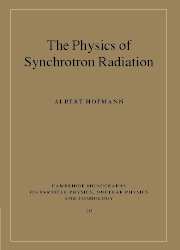Book contents
- Frontmatter
- Contents
- Preface
- Acknowledgments
- Notation
- Part I Introduction
- Part II Synchrotron radiation
- 4 Synchrotron radiation: basic physics
- 5 Synchrotron radiation: properties
- Part III Undulator radiation
- Part IV Applications
- A Airy functions
- B Bessel functions
- C Developments of strong-undulator radiation
- References
- Index
4 - Synchrotron radiation: basic physics
Published online by Cambridge University Press: 09 October 2009
- Frontmatter
- Contents
- Preface
- Acknowledgments
- Notation
- Part I Introduction
- Part II Synchrotron radiation
- 4 Synchrotron radiation: basic physics
- 5 Synchrotron radiation: properties
- Part III Undulator radiation
- Part IV Applications
- A Airy functions
- B Bessel functions
- C Developments of strong-undulator radiation
- References
- Index
Summary
Introduction
The radiation emitted by a charged particle moving with constant, relativistic speed on a circular arc is called synchrotron radiation. It is sometimes also called ordinary synchrotron radiation or bending-magnet radiation to distinguish it from the more general case of a non-circular trajectory like undulator radiation. On some occasions this radiation will be abbreviated as SR.
Some approximations are made in treating synchrotron radiation. First we assume that the radiation is emitted in a long magnet that has a constant field providing a constant curvature 1/ρ over a distance ℓr > 2ρ/γ. Secondly, the radiation is observed at a relatively large distance from the source rp ≫ ρ/γ. This approach is similar to the development of a general field into dipole, quadrupole, and higher-multipole components, for which the higher-order contributions become negligible at large distances. For an ultra-relativistic charge the opening angle of the emitted radiation is of order 1/γ and therefore very small. The radiation received originates from a small part of the trajectory and the observer is usually far away compared with this small source size. The third approximation assumes that the particle moves with ultra-relativistic velocity, γ ≫ 1, which leads to some simplifications. All three approximations are satisfied for most practical sources of synchrotron radiation.
- Type
- Chapter
- Information
- The Physics of Synchrotron Radiation , pp. 57 - 80Publisher: Cambridge University PressPrint publication year: 2004



